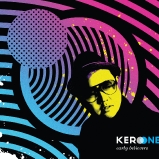
When Kero One released his debut album Windmills of the Soul, he had no backing and no name recognition to speak of. The album’s success came about through his persistent work to get it heard which resulted in it becoming a hit in Japan first, a humorous twist for a Korean DIY hip-hopper born and raised in the San Francisco Bay Area. Through this success, he has managed to remain independent, starting Plug Label, releasing The Tones’ debut album and doing end-to-end production on his sophomore release Early Believers.
It is this spirit and energy that infuses Early Believers with an unfettered sense of optimism and musical joy. From the instrumentation to the lyrics, the album is unmistakably a complete work by a focused artist. The music is consistent and full, utilizing both hip-hop and jazz influences, while the lyrics are often personal and focused on a specific story. The marriage between Kero’s thoughts and his beats serve to offer an album that never feels forced or out of place. Unlike some current hip-hop albums that feel like the goal is musical shock for shock’s sake, Kero One never tries to do too much or move too far out of his range. On the opening track “Welcome to the Bay,” Kero raps about the pros and cons of the area where he grew up over an easy synth and fresh beat produced by King Most. Jacqueline Marie provides the chorus about the mentality of never leaving the bay for a piece that is heartfelt and unmistakably San Francisco.
“When the Sunshine Comes” is an easy, sunny day melody. The pace and mood of this song seem to be the best fit for Kero’s vocals, letting him sit back and rap without tempo pressure. The smooth delivery of tongue twisters is unhurried enough that it doesn’t make the listener feel stressed that the words won’t come out. This track gives way to “Keep Pushin’,” a much more up-tempo track that lyrically resembles something Kanye might have produced, with a little more pop to it. The fusion of jazz and a glitchy stop-and-go guitar/handclap back and forth brought to mind edIT’s “Crunk de Gaulle” off Certified Air Raid material. On his “I’m better off single” track, “Let’s Just Be Friends,” Kero brings a sing-along melody to the chorus (performed by Tuomo) and manages to make his desire to stay single sound happy and upbeat. The album then moves into Latin Jazz influences on “Bossa Soundcheck,” where Kero displays the keyboard and piano education he was brought up on. Sounding like it would be best heard in a dimly lit lounge atmosphere, Kero manages to make a hip-hop song that would fool non-hip-hop fans into listening and enjoying.
A solid feature of Kero One’s music is that he doesn’t sacrifice his choruses like most contemporary hip-hop and rap acts have done to get radio air-play. There’s no, “she made us drinks to drink, we drunk them, got drunk” fillers here. The choruses are integral parts of the overall whole, demonstrated again through Tuomo’s easy delivery on “Love and Happiness,” bringing to mind some of the better work done with Codany Holiday on Zion I’s latest album. This is the second King Most produced track on the album, and together they make the only two not produced by Kero himself. In “Stay on the Grind” Kero raps about the difficulties and rewards of choosing the DIY route, and just when you thought the whole album would be hip-hop, “A Song for Sabrina” shows off the instrumental prowess in a hip-hop/jazz/funk fusion track that includes Vince Czekus on bass and electric guitar.
In the most poignant and introspective track on the album, “This Life Ain’t Mine,” Kero uses an easy and straight-forward hip-hop track to back an autobiographical story about his life and entry into the hip-hop career, looking at his choices in friends and religion. The easy keys sprinkle melodies over “I Never Thought That We” as Kero looks at his unlikely and unpredictable path from his parents’ wishes to his chosen career. And, without missing a step, the album ends on a Kero One exclusive instrumental, “On and On,” which lets the album fade out in a jazzy way, reminding the listener of the progression of the album as a whole, and that it wasn’t just rap or hip-hop you were listening to.
An easy listen, Kero One’s Early Believers takes chill to the next level at every step. Gone from this album are the stereotypes that you need raps about money and women, pop-induced repetitive hooks and coarse language to produce a solid hip-hop outing. Instead, Kero relies on excellent production, live instrumentation and honest lyrics from his point of view to make an album that flows from start to finish and will most likely end the year in more than a few top ten lists. While it isn’t edgy or controversial, and some listeners will harp on a lack of perceived street credibility, Early Believers reminds us that hip-hop doesn’t need to be any of those things to be fun. Early Believers will be available from Plug Label on April 7th. Check back here for our exclusive interview with Kero One.



